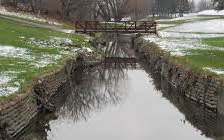Science > Biology > Soil Management > Prevention of Soil Erosion
Different methods of prevention of soil erosion are discussed below
Vegetation:
The simplest and most natural way of prevention of soil erosion is through planting vegetation. Erosion of soil from baren land is more, hence the soil must be kept covered by growing grass and planting trees on it. The grass reduces the speed of flow of water and minimizes direct contact of water with soil. While Plants establish root systems, which stabilizes soil and prevents soil erosion. While their leaves block rain and reduce the impact of the drop on the soil, Thus plants stop rain breaking the soil apart.
Applying Mulches:
Applying mulches is another method of prevention of soil erosion. Applying a layer of mulch to the soil top allows the soil to slowly soak up water, as it protects against rain impact, and restores pH levels. Mulching is done by putting dead leaves and shredded wood on the soil. Mulching acts as a protective covering for the tree and plants against extreme weathers. Mulching allows water to reach the soil slowly, and thus reduce the impact of rainfall or heavy watering. Mulches help to prevent the soil from turning acidic and suppresses weeds from growing. Over time, mulches made from organic materials break down and increase soil’s structure and fertility.
Matting the soil:
Matting is the process of covering the soil with biodegradable materials that include mulch, straw, coconut fiber, and wood chips. These are held together with biodegradable netting made from coco coir. It is like covering the soil with a biodegradable carpet. In due course, the matting material can decompose or decay and turn to soil fertilizer.
Building retaining walls:
Sloping land may collapse downhill until it is stabilized. A retaining wall at the base of the slope will block the creep of the soil and slow down the collapse. Retaining wall also prevents water runoff. Runoff water leads to further erosion Wall can be made up of stones and concrete.

Turning Hill Side into Terrace or Contour Farming:
The erosion of soil on sloping land is more. The steepest slopes are almost impossible to farm on. Turning the hill into terraces running across the slope can reduce soil erosion. Here the soil should be arranged horizontally across the line of the slope so as to reduce soil erosion. Contour farming act as reservoirs to catch and retain rainwater, thus permitting increased infiltration and more uniform distribution of the water.

Bunding:
A bund is an engineering measure of prevention of soil erosion, used for creating obstruction across the path of surface runoff to reduce the velocity of flowing water. It retains the running off the water in the watershed and thus to help to control soil erosion. Similarly, the contour canal can be dug across the flow of water. Contour bunds are laid out in those areas which have less rainfall and permeable soils.


Reduce Watering:
Over-watering garden or field can speed up erosion by washing away soil. Use less water if possible. Installation of the drip irrigation system is the best option. Since a drip system only delivers small amounts of water at a time, there is no water flooding across the surface to carry topsoil.
Avoid Soil Compaction:
When people, animals, or machines travel over the soil, they press it down, compacting the soil into a dense layer. Due to compaction, the distance between the particles of soil decreases. Hence water and air get difficulty in penetrating the soil. Hence a paving stone path should be created for movement instead of trampling the soil.
Creation of Windbreakers:
In this method evergreen trees are planted around gardens or farmland, to prevent the wind from blowing away the soil. Windbreakers help in protecting crops from damage caused by strong & severe wind and improve plant health, quality, and yield. Crop protected from the wind is able to retain significantly more moisture.
Prevention of Coastal Erosion:
Coastal erosion occurs when the waves that lap at the coast slowly wear away at the shoreline. As these waves wash over the shore, they carry sand and sediment with them and redistribute it to the ocean floor or to other areas. Due to erosion, islands are becoming narrower and coastlines are retreating. Heavy rain and wind rapidly move sand off the dunes and cause oceans to climb higher and higher onto the beach. There are several different methods that have been used in various places to prevent coastal erosion. Some of these methods have worked fairly well, but there are always different drawbacks and advantages to each. Some of the most common methods to prevent coastal erosion are as follows:
Groins:
Groins are man-made structures designed to trap sand as it is moved down the beach by the longshore drift. Longshore drift is a process of transportation. It involves eroded material being moved along a coastline. Groins are long, wall-like structures that are built on beaches and extend into the ocean perpendicular to the shoreline. They act as a barrier to longshore currents. As the longshore current hits the groin, it loses velocity and dumps sand and sediment on the up current side of the wall. While this catches sand on the up current side of the wall, it leads to more erosion on the down current side of the wall, where the waves once again pick up sand and sediment.

Jetties:
Jetty is a man-made wall that is placed along the sides of an inlet. The reason that jetties are installed is to prevent the inlet from shifting positions and to keep it open permanently. This solution involves constructing a line of long structures perpendicular to the coast that reaches into the ocean. These are usually made from stone, concrete, steel, or timber, and are designed to keep sand from entering a ship channel. As sand builds up on against the up current side of the jetties, it can be redistributed along the beach to further reduce erosion. The erosion still occurs on the down current side of the jetties.

Breakwaters:
Breakwaters consist of large piles of rocks laid parallel to the shore. Breakwaters are generally used to calm waters for harbors and artificial marinas. They act as a wave barrier, allowing the beach to grow while preventing harmful erosion. As waves hit the breakwater, they deposit their load of sediment along with it. However, any part of the coast not protected by the breakwater continues to experience erosion

Social Forestry:
To prevent soil erosion land should be vegetatively covered. Grass and trees should be grown on barren lands. Forests should be conserved. Thus forests should be saved from destruction. To increase the forest land and to motivate the common man, the government started a social forestry plan. People are motivated to plant trees in all possible places, such as borders of fields, both sides of the road, railway tracks, on banks of rivers, streams, etc. Adivasis and small farmers have been given incentives to increase their participation in the scheme. Using these barren lands are reclaimed for agriculture. There is an increase in green cover.
6 replies on “Prevention of Soil Erosion”
I really super content
good compilation!
Good information….
I LOve this
really very useful information for the engineers working in irrigation department, usually come across the problem to protect the sides of the canals / drains banks
Nice